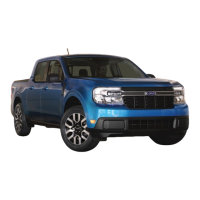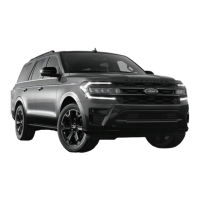
Do you have a question about the Ford MAVERICK 2022 and is the answer not in the manual?
| Brand | Ford |
|---|---|
| Model | MAVERICK 2022 |
| Category | Automobile |
| Language | English |
Provides guidance on understanding your vehicle and the owner's manual's content and features.
Contains important information about new vehicle limited warranty and special instructions for vehicle operation.
Illustrates common symbols found on the vehicle's exterior and interior for identification.
Details data collection and usage for services subscribed to, including account and driving data.
Recommends reviewing terms for third-party services and states Ford's non-responsibility for them.
Explains vehicle data collection by recorders for diagnostics, service, and improvement purposes.
Describes the function of the event data recorder, capturing vehicle dynamics during crashes.
Covers electronic control units storing data for personalized settings like climate and radio presets.
Explains data transmission via modem for software updates and diagnostics.
Details data collected when connecting mobile devices, including phonebook and call history.
Describes disclosure of vehicle information to emergency services during a crash.
Identifies controls on the steering wheel and their functions, like cruise control and voice recognition.
Locates key features on the instrument panel, including cluster overview and climate control.
Highlights interior features such as seating position and pickup bed anchor points.
Points out exterior features like wiper blades, mirrors, and door lock mechanisms.
Identifies rear exterior components such as the tailgate, stoplamp bulb, and rear view camera.
Provides essential safety warnings and guidelines for securing children in the vehicle.
Explains what child restraint anchor points are and how to locate them.
Offers information on child restraint types, position, and recommended restraint types by size.
Details steps for installing child restraints using seatbelts or LATCH systems.
Guidance on using booster seats for children who have outgrown child restraints.
Explains how to operate the child safety locks on the rear doors.
Provides critical warnings and guidelines for proper seatbelt usage and occupant safety.
Details the procedure for properly fastening and unfastening the vehicle's three-point seatbelts.
Explains the seatbelt retractor feature for shoulder belt length adjustment and locking.
Describes the safety feature that keeps seatbelts pre-locked.
Includes guidance on adjusting seatbelts for pregnancy and correct height adjustment.
Explains how the system monitors seating positions and provides audio/graphic feedback.
Provides instructions for periodically checking seatbelts and child restraint anchor points.
Addresses the use of seatbelt extensions and warnings associated with their use.
Describes the advanced safety system that protects occupants in frontal crashes.
Explains how front airbags deploy during significant frontal crashes and their components.
Details side airbag deployment, location, and system components.
Explains how driver knee airbags work and activate based on crash conditions.
Describes how the Safety Canopy airbag system deploys during side crashes and rollovers.
Provides critical safety warnings regarding airbag deployment and occupant positioning.
Guides on proper seat adjustment for optimal safety and airbag interaction.
Warns against placing rearward-facing child restraints in front of active airbags.
Explains the system that detects occupants to enable/disable front passenger airbags.
Describes crash sensors, restraints control module, and system readiness indicators.
Instructs to contact an authorized dealer for safe airbag disposal.
Describes 911 Assist as a SYNC feature that calls for help after a crash.
Lists requirements for 911 Assist to function, including phone pairing and vehicle power.
Outlines limitations of the SYNC 911 Assist feature, such as crash damage or power loss.
Details limitations and conditions affecting remote control functionality.
Explains how to use the remote control for various vehicle systems like unlock, lock, and remote start.
Provides instructions on how to open and close the flip key.
Illustrates the process of removing the key blade from the remote control.
Describes how to activate and deactivate the panic alarm.
Explains how to use the lock button to locate the vehicle via turn signal flash.
Provides step-by-step instructions for replacing the remote control battery.
Advises purchasing replacement keys or remotes from an authorized dealer.
Instructs to contact an authorized dealer for programming remote controls.
Provides troubleshooting information for key and remote control issues.
Introduces MyKey as a feature for programming keys with restricted driving modes.
Details non-configurable and configurable MyKey settings like seatbelt reminder and speed limit.
Provides step-by-step instructions for creating a MyKey for vehicles with or without push-button start.
Explains how to program restrictions to keys and use admin keys for MyKey functions.
Describes how to remove all MyKey restrictions and return keys to admin status.
Guides on how to find information about programmed MyKeys using the information display.
Offers troubleshooting for MyKey issues, including information messages.
Instructions for unlocking and locking doors using the remote control and key blade.
Details how to use the central locking and individual door lock controls.
Explains the feature that unlocks doors when the vehicle stops and how to switch it on/off.
Describes the feature that locks doors automatically when starting to drive.
Defines mislock and its limitations, including switching it on/off.
Provides troubleshooting for door and lock issues, including warning lamps and information messages.
Lists conditions that may prevent the remote control or system from functioning.
Guides on switching keyless entry on/off and reprogramming the unlocking function.
Details how to unlock and lock doors using the passive key and touch sensors.
Addresses common issues and questions related to keyless entry system functionality.
Introduces the keypad for locking/unlocking vehicle using the keypad on the window trim.
States conditions that may prevent the keypad from functioning.
Describes the location of the keypad near the driver window.
Explains the factory-set five-digit master access code for keypad operation.
Provides instructions for programming personal entry codes for the keypad.
Details how to use the keypad for unlocking and locking doors.
Addresses issues with keypad access code and keypad functionality.
Warns against riding in the cargo area and improper load securing for safety.
Covers opening the tailgate from outside and to the middle position.
Provides instructions for manual and power locking/unlocking the tailgate.
Details the procedure for removing and installing the tailgate, including safety warnings.
Explains the system that prevents starting the vehicle with an incorrect coded key.
Describes the alarm system that warns of unauthorized entry and its operation.
Provides troubleshooting tips for security systems, including information messages.
Instructions on how to adjust the steering wheel position for safe driving.
Explains how to activate the horn by pressing the center of the steering wheel.
Details how to activate and deactivate the heated steering wheel feature.
Covers wiper precautions and how to switch windshield wipers on and off.
Provides washer precautions and instructions for using the windshield washer.
Addresses troubleshooting for wipers and washers, including warning lamps and FAQs.
Explains the exterior lighting control functions and default settings.
Details how to use high beam headlamps and switch headlamp exit delay on/off.
Explains how the automatic high beam control works, its requirements, limitations, and overrides.
Covers switching turn signal and daytime running lamps on/off.
Describes how interior lamps turn on and off based on door status and remote control.
Explains how to turn front interior lamps on and off by pressing the lamp lens.
Details how to turn rear interior lamps on and off by pressing the lamp lens.
Defines the interior lamp function for courtesy and door lamps.
Guides on adjusting instrument panel lighting brightness using dimmer buttons.
Covers switching ambient lighting on/off and adjusting its intensity for different SYNC versions.
Addresses common interior lighting issues and questions.
Provides instructions for operating power windows, including one-touch features and resetting memory.
Explains that window switches remain operational after ignition off until front door opens.
Describes the feature that stops and reverses windows if an obstacle is detected.
Provides warnings and instructions for overriding the window bounce-back feature.
Explains how to lock or unlock rear window controls using the control button.
Details how to operate sliding windows using the control switch.
Warns against adjusting mirrors while the vehicle is moving due to loss of control risk.
Explains how to pull the tab below the mirror to reduce glare at night.
Instructions for adjusting mirror position using the control light and adjustment control.
Warns that objects in the mirror are closer than they appear and describes blind spot mirror function.
Details how to fold exterior mirrors by pushing them toward the door window glass.
Provides instructions for manually opening and closing the sun shade.
Explains how to open and close the moonroof using one-touch feature.
Details how to vent the moonroof from the closed position.
Describes the feature that stops and reverses moonroof if an obstacle is detected.
Provides instructions on overriding the moonroof bounce-back feature.
Identifies components of the instrument cluster for gasoline models with a 4.2-inch screen.
Identifies components of the instrument cluster for gasoline models with a 6.5-inch screen.
Identifies components of the instrument cluster for HEV models with a 4.2-inch screen.
Identifies components of the instrument cluster for HEV models with a 6.5-inch screen.
Explains the tachometer function, indicating engine speed.
Describes the power gauge function for HEV models, showing power to wheels during acceleration.
Explains the speedometer's function to indicate vehicle speed.
Details the fuel gauge function and limitations.
Explains the engine coolant temperature gauge function.
Describes the information bar displaying ambient temperature, odometer, compass, and indicators.
Explains warning lamps that alert to vehicle conditions requiring attention.
Lists indicators that notify the driver of active features and their status.
Guides on using steering wheel controls to navigate display menus and features.
Details the main menu structure for 4.2-inch and 6.5-inch screens.
Instructions on adding screens, configuring gauges, and personalizing display settings.
Covers changing display language, measurement units, and temperature units.
Explains fuel economy gauges for gasoline and hybrid electric vehicles.
Guides on using EV Coach to maximize electric driving capabilities.
Describes Brake Coach, which coaches braking for regenerative energy recovery.
Details the trip summary display showing cumulative values since last vehicle start.
Instructions for accessing the trip computer for 4.2-inch and 6.5-inch screens.
Guides on resetting the trip computer and individual trip values.
Details on configuring the trip computer view and selecting display values.
Explains Trip 1 and 2 data, including timer, fuel economy, and distance traveled.
Describes the system that allows remote starting and interior temperature adjustment.
Provides critical warnings about starting the engine in enclosed areas due to toxic exhaust fumes.
Lists conditions under which remote start does not work, like sounding alarm or low battery.
Guides on enabling remote start via vehicle settings menu.
Details how to remotely start and stop the vehicle using the remote control.
Explains how to extend the remote start duration during operation.
Describes remote control feedback LEDs for status of remote start/stop commands.
Covers switching climate control auto mode and last settings on/off.
Identifies the climate control unit and its buttons.
Explains how to turn the climate control system on and off.
Details how to recirculate air to improve heating or cooling efficiency.
Explains how to switch air conditioning on and off.
Describes how to use maximum defrost for defogging and clearing ice.
Details how to switch maximum cooling on and off.
Explains that heated wiper park turns on with heated mirrors.
Details how to switch heated mirrors on and off.
Guides on setting the blower motor speed using the control.
Explains how to set left and right temperatures using the climate control.
Describes how to direct airflow to windshield, instrument panel, or footwell vents.
Covers switching auto mode on/off and adjusting blower motor or air distribution.
Addresses common climate control issues and frequently asked questions.
Identifies the climate control unit and its buttons.
Explains how to turn the climate control system on and off.
Details how to recirculate air to improve heating or cooling efficiency.
Explains how to switch air conditioning on and off.
Describes how to use maximum defrost for defogging and clearing ice.
Details how to switch maximum cooling on and off.
Explains that heated wiper park turns on with heated mirrors.
Details how to switch heated mirrors on and off.
Guides on setting the blower motor speed using the control.
Explains how to set left and right temperatures using the climate control.
Describes how to direct airflow to windshield, instrument panel, or footwell vents.
Covers switching auto mode on/off and adjusting blower motor or air distribution.
Addresses common climate control issues and frequently asked questions.
Explains the cabin air filter's function in improving air quality by trapping particles.
Provides instructions for replacing the cabin air filter behind the glove compartment.
Offers warnings about improper seating positions and reclining the seat backrest.
Recommends guidelines for proper seating, including upright posture and distance from the steering wheel.
Details head restraint components and adjustments for manual seats.
Describes adjustments for seat height, backrest, lumbar support, and head restraint.
Provides precautions and instructions for switching heated seats on and off.
Details head restraint components and adjustments for manual rear seats.
Provides warnings about unlatched or folded seats and securing cargo.
Offers warnings about folding seats when occupied or potential finger entrapment.
Guides on unfolding seat backrests, ensuring seatbelts are not trapped.
Explains the system that monitors vehicle conditions to check for rear seat occupants.
Describes how the system monitors rear doors and indicates potential occupant presence.
Provides warnings about vehicle temperature and leaving children unattended.
States that the system does not detect objects and monitors door status.
Guides on switching the system on or off via the touchscreen.
Shows the message displayed when alert conditions are met and how to acknowledge it.
Explains the audible warnings that sound when alert conditions are met.
Identifies locations for data transfer and charge-only USB ports.
Details how to connect a device and play media via USB.
Explains how to connect a device to the USB port for charging.
Describes the power outlet's capability to power devices using a household plug.
Provides critical warnings about keeping devices plugged in and avoiding extension cords.
Lists limitations regarding devices exceeding power ratings and recommended usage.
Identifies potential locations for the power outlet on the instrument panel or center console.
Explains the indicator lights for power status and fault mode.
Describes the power outlet's capability to power devices using a 12V adapter.
Provides warnings about using the power outlet and preventing battery discharge.
Lists potential locations for power outlets on the instrument panel and consoles.
Explains the prewired 12V circuit in the auxiliary power access for electrical accessories.
Introduces the wireless charger for compatible Qi devices.
Provides warnings about charging devices affecting medical devices and proper handling.
Identifies the charging area on the center console or media bin.
Details placing the device on the charging surface for charging.
Addresses troubleshooting for wireless charger messages and behavior.
Offers caution when stowing items or hot drinks in cup holders.
Describes how to locate the under seat storage compartment.
Explains how to locate and open the glasses holder in the overhead console.
Covers locating and opening pickup bed storage.
Provides critical warnings about idling, parking on dry grass, and starting in enclosed areas.
Explains switching the ignition off, to accessory mode, and on.
Details how to switch ignition off, to accessory mode, and start the engine.
Provides instructions for starting gasoline and hybrid electric vehicle engines.
Covers engine block heater precautions and operation.
Details how to stop the engine when stationary or moving.
Explains the feature that switches the engine off after extended idling to save fuel.
Addresses issues with engine starting/stopping, including warning lamps and information messages.
Defines a hybrid vehicle as having an electric motor and high voltage battery with a gasoline engine.
Explains how the hybrid vehicle combines electric and gasoline propulsion for optimal performance.
Describes how the gasoline engine starts and stops to save fuel and conditions that affect engine operation.
Details indicators like the green READY light and engine start behavior.
Addresses troubleshooting for HEV information, including warning lamps and messages.
Answers common questions about the high voltage battery system and fuel/engine behavior.
Explains the system that reduces fuel consumption by stopping and restarting the engine.
Provides critical warnings about applying the parking brake and switching off the ignition.
Guides on switching the auto-start-stop system on and off.
Instructions on how to stop the engine while vehicle is in drive (D).
Details how to restart the engine by releasing the brake or pressing the accelerator.
Explains the meaning of the green and amber indicators for auto-start-stop system.
Addresses issues with the auto-start-stop system, including information messages.
Answers common questions about why the engine doesn't always stop or restarts unexpectedly.
Provides critical warnings about overfilling the tank, fuel system pressure, and fuel hazards.
Guides on filling a portable fuel container and adding fuel from it.
Covers refueling procedures for gasoline and hybrid electric vehicles, including manual filler door opening.
Lists advertised and actual fuel tank capacities.
Addresses troubleshooting for fuel and refueling, including warning lamps and information messages.
Explains the catalytic converter's role in filtering pollutants from exhaust gas.
Provides warnings about working around the hot exhaust system and catalytic converter.
Addresses troubleshooting for catalytic converter issues, including warning lamps.
Defines the high voltage battery as a lithium-ion system for storing electrified energy.
Provides critical warnings about servicing the battery pack and handling high-voltage components.
Offers warnings about shifting gears while stationary and applying brake/accelerator pedals.
Details transmission positions (P, R, N, D, L) and their functions.
Explains the mode that keeps the vehicle in neutral when switched off.
Describes how the vehicle shifts to park (P) when exiting without park engaged.
Explains grade assist for downhill driving, combining engine motoring and battery charging.
Details manual park release for electrical malfunctions or emergencies.
Provides instructions for activating the manual park release cable.
Describes audible warnings related to transmission status, like 'Not In Park'.
Addresses troubleshooting for automatic transmission issues, including information messages.
Offers warnings about driving with warning lamps on and extended parking brake use.
Explains the ABS limitations and indicators.
Provides instructions for handling a stuck or entrapped accelerator pedal.
Guides on locating the brake fluid reservoir under the hood.
Details how to check brake fluid level and the importance of using correct fluid.
Specifies the recommended brake fluid type and standards.
Addresses troubleshooting for brakes, including warning lamps and FAQs.
Defines the electric parking brake's function for holding the vehicle on slopes and flat roads.
Provides instructions and warnings for applying the electric parking brake.
Explains using the electric parking brake to slow or stop the vehicle in an emergency.
Details the procedure for manually releasing the electric parking brake.
Guides on starting on a hill with a trailer attached, using the parking brake and accelerator.
Explains the automatic release process when shifting into gear and pressing the accelerator.
Describes the audible warning when the parking brake is on and the vehicle is moving.
Refers to jump starting precautions for releasing the brake when the battery is dead.
Addresses troubleshooting for electric parking brake issues, including warning lamps and messages.
Explains Hill Start Assist's function to help pull away on slopes without the parking brake.
Describes how the system holds the vehicle stationary after releasing the brake pedal.
Provides warnings that Hill Start Assist does not replace the parking brake.
Addresses troubleshooting for Hill Start Assist, including information messages.
Explains Auto Hold's function of applying brakes to hold the vehicle after stopping.
Guides on switching the Auto Hold system on and off using the center console button.
Details the steps to bring the vehicle to a stop and release the brake pedal.
Shows indicators for when the system is active or cannot hold the vehicle.
Explains how the system applies brakes to individual wheels and reduces power to increase traction.
Guides on switching traction control on and off using the center console button.
Describes the traction control light behavior during startup and activation.
Addresses troubleshooting for traction control issues, including system messages.
Explains how stability control prevents skids and lateral slides by applying brakes.
Details how electronic stability control prevents skids by applying individual wheel brakes.
Explains how roll stability control prevents rollovers by detecting roll motion.
Describes how curve control enhances cornering ability by reducing engine power or applying brakes.
Explains how traction control maintains wheel traction by controlling wheel spin.
Shows when the stability control system is active and its status.
Addresses troubleshooting for stability control, including warning lamps.
Explains Hill Descent Control's function to set and maintain vehicle speed on downhill slopes.
Describes how the system maintains vehicle speeds on downhill slopes.
Provides warnings about system limitations in low traction or steep slope conditions.
Guides on switching Hill Descent Control on and off using the center console button.
Explains how to increase or decrease descent speed using steering wheel buttons.
Shows the indicator that illuminates when Hill Descent Control is on.
Addresses troubleshooting for Hill Descent Control, including information messages.
Explains how electric power steering works, including adaptive learning.
Provides warnings about system diagnostic checks and potential loss of steering control.
Addresses troubleshooting for steering issues, including information messages.
Offers warnings about using parking aids, sensor limitations, and potential false alerts.
Explains what the rear parking aid is and its limitations.
Addresses troubleshooting for parking aids, including information messages.
Alerts of vehicles approaching from sides behind the vehicle when shifting into reverse.
Provides warnings about not using the system as a replacement for careful driving.
Lists conditions where cross traffic alert may not operate correctly.
Guides on switching cross traffic alert on or off via the instrument cluster display.
Shows indicators for cross traffic alert detection and system malfunctions.
Addresses troubleshooting for cross traffic alert issues, including information messages.
Describes the rear view camera providing a video image of the area behind the vehicle.
Provides warnings about using the camera with interior/exterior mirrors and reversing slowly.
Notes that active and fixed guide lines are available when the transmission is in reverse (R).
Explains how to zoom the rear view camera using the touchscreen symbols.
Explains cruise control's function to maintain set speed without foot on accelerator.
States that cruise control is usable when vehicle speed is greater than 20 mph (30 km/h).
Provides warnings about using cruise control in winding roads or slippery conditions.
Guides on setting preferred speed and changing set speed increments.
Explains how to cancel set speed using the button or brake pedal.
Details how to resume the set speed using the RES button.
Shows the indicator that illuminates when the cruise control system is on.
Explains how ACC uses sensors to maintain gap and set speed, including complete stops.
Provides critical warnings about driver responsibility and system limitations.
Details sensor limitations and conditions affecting system performance.
Guides on switching ACC on/off using steering wheel controls.
Explains conditions that cause automatic cancellation of ACC.
Details how to set the adaptive cruise speed from a complete stop or manually.
Explains how to cycle through the four gap settings.
Explains how lane centering uses sensors to help keep the vehicle in the lane.
Provides warnings about system use while towing or if steering wheel modifications are made.
States that driver must keep hands on steering wheel and system activates under specific conditions.
Lists conditions where lane centering may not operate correctly.
Guides on switching lane centering on and off using steering wheel controls.
Describes Alert Mode, which vibrates the steering wheel for unintended lane departure.
Explains Aid Mode, providing temporary steering assistance toward the lane center.
Combines features for lane keeping, providing steering input and vibration alerts.
Shows indicators for lane keeping system status (gray, white, yellow, red).
Addresses troubleshooting for lane keeping system issues, including information messages.
Explains the system that detects vehicles in the blind spot zone.
Describes how the system uses sensors to detect vehicles and alert the driver.
Provides warnings about not using the system as a replacement for careful driving.
Lists limitations of the blind spot system, such as not operating in park or reverse.
States when the blind spot system turns on, requiring vehicle start and drive shift.
Guides on switching the blind spot system on or off using the instrument cluster display.
Shows indicators in the exterior mirror when a vehicle is detected.
Addresses troubleshooting for blind spot system issues, including information messages.
Explains the system that alerts of vehicles approaching from the sides when shifting into reverse.
Describes how the system detects approaching vehicles and provides alerts.
Provides warnings about not using the system as a replacement for careful driving.
Lists conditions where cross traffic alert may not operate correctly.
Guides on switching cross traffic alert on or off via the instrument cluster display.
Identifies the sensor locations behind the rear fascia panel.
Shows indicators for cross traffic alert detection, including tones and arrows.
Addresses troubleshooting for cross traffic alert issues, including information messages.
Explains pre-collision assist's function to detect and warn of approaching hazards.
Describes the system's three levels of assistance: Alert, Brake Support, and AEB.
Provides critical warnings about driver responsibility and system limitations.
Details limitations based on camera/sensor ability, weather, and vehicle conditions.
States pedestrian detection is active up to 50 mph (80 km/h) and optimal conditions for detection.
Explains that the system cannot be switched off.
Guides on adjusting alert sensitivity, distance indication, AEB, and evasive steering assist.
Identifies the camera and radar sensor locations.
Explains distance indication displays the gap between vehicles.
Describes how the system alerts with a warning lamp if distance to vehicle ahead is small.
Explains AEB activation if collision is imminent to reduce impact damage.
Describes how evasive steering assist helps steer around road users.
Addresses troubleshooting for pre-collision assist issues, including information messages.
Explains Driver Alert's function to detect driver drowsiness or deteriorating driving.
Describes how Driver Alert calculates alertness based on driving behavior and camera sensor.
Provides critical warnings about driver responsibility and taking regular rest breaks.
Lists conditions where driver alert may not function correctly.
Guides on switching the Driver Alert system on or off using the instrument cluster display.
Explains how to reset the system by switching ignition off/on or stopping the vehicle.
Describes system warnings in two stages: temporary rest advice and further warning.
Addresses troubleshooting for driver alert issues, including information messages.
Emphasizes keeping loaded vehicle weight within design ratings and understanding weight terms.
Recommends against using the pickup for carrying a slide-in camper.
Guides on finding the safety compliance certification label on the vehicle.
Defines GAWR as the maximum allowable weight for a single axle.
Defines GVWR as the maximum allowable weight of the fully loaded vehicle.
Defines GCWR as the maximum allowable weight of the vehicle and loaded trailer.
Provides steps for calculating payload and load limit.
Offers warnings about exceeding GVWR/GAWR and towing beyond recommended limits.
Warns against connecting trailer hydraulic brakes directly and using electric brakes without a controller.
States that load capacity is by weight, not volume, and reduced performance at high altitudes.
Provides guidelines to minimize trailer movement effects, like loading heaviest items closest to floor.
Offers hints for towing, including inspecting components and managing takeoff vibration.
Provides guidelines for backing down ramps, avoiding water entry and waves.
Provides recommended towing weights by market and website for detailed information.
Defines maximum loaded trailer weight as the highest possible weight of a fully loaded trailer.
Provides steps to calculate maximum loaded trailer weight by subtracting vehicle weights.
Assists in smooth trailer braking based on towing vehicle's brake pressure.
Provides warnings about adjusting trailer brakes and checking connections.
Guides on ensuring trailer brakes are functional and making electrical connections.
Explains how to adjust gain setting for desired trailer braking assistance.
Covers selecting controller mode using instrument cluster display.
Guides on selecting trailer brake type (Default, Electric/Surge/None).
Explains selecting setting for trailer brake initial voltage or aggressiveness.
Addresses troubleshooting for integrated trailer brake controller, including information messages.
Explains how the system applies brakes and reduces engine torque to aid vehicle stability.
Provides critical warnings about turning off trailer sway control and its risks.
Guides on switching trailer sway control on or off via instrument cluster display.
Notes that component operation may be affected by temperatures below -13°F (-25°C).
Provides critical warnings about driving cautiously in slippery conditions.
Recommends a break-in period for the first 1,000 mi (1,600 km) to avoid driving at high speeds.
Offers tips to improve fuel consumption, like driving smoothly and checking tire pressure.
Covers emergency maneuvers and driving through mud and water.
Advises caution in mud and deep water, and how to dry brakes after driving through water.
Provides warnings about extreme care when steering in reverse down slopes.
Guides on driving in sand, keeping wheels on solid areas and avoiding excessive wheel slip.
Warns against crossing deep or flowing water and driving through standing water.
Provides warnings about using correctly designed floor mats and securing them.
Details the complimentary roadside assistance program for US and Canadian customers.
Provides precautions for damage or fire involving electric or hybrid-electric vehicles.
Outlines emergency response procedures for crashes, including vehicle shutdown and key removal.
Advises to call emergency assistance immediately for fires and maintain safe distance.
Provides precautions and instructions for jump starting a vehicle, including cable connection.
Explains the system designed to turn on hazard flashers and sound the horn after a serious impact.
Describes the system designed to stop fuel to the engine in moderate or severe crashes.
Provides steps to attempt to restart the vehicle after automatic crash shutoff.
Covers accessing the front towing point and warnings about using recovery hooks.
Provides warnings about disconnecting the battery and replacing fuses with correct amperage.
Guides on locating and accessing the under hood fuse box.
Covers locating and identifying fuses in the body control module fuse box.
Illustrates and identifies different types of fuses used in the vehicle.
Addresses troubleshooting for fuses, including frequently asked questions.
Emphasizes regular servicing at authorized dealers and using recommended parts.
Provides instructions for opening and closing the vehicle's hood.
Identifies components under the hood for 2.0L EcoBoost™ and 2.5L Hybrid Electric Vehicle (HEV).
Covers engine oil dipstick overview, checking oil level, adding oil, and resetting oil change reminder.
Provides engine oil capacity and specification details for 2.0L EcoBoost™ and 2.5L HEV.
Recommends alternative engine oil for extremely cold climates.
Guides on checking coolant concentration and level, and adding coolant.
Details coolant change intervals and proper disposal of used coolant.
Explains fail-safe cooling for temporary driving before repairs.
Provides instructions for changing the engine air filter for both EcoBoost and HEV models.
States the fuel filter is lifetime and does not require regular maintenance.
Illustrates drive belt routing for the 2.0L EcoBoost™ engine.
Provides warnings and instructions for removing and reinstalling the 12V battery.
Advises on proper disposal of old batteries.
Covers vertical and horizontal aim adjustment for headlamps.
Provides an exterior bulb specification chart with lamp, specification, and power.
Details steps for removing the rear lamp assembly.
Provides instructions for changing a front turn signal lamp bulb.
Details how to change a front side marker lamp bulb.
Provides instructions for changing rear lamp bulbs.
Details how to change a stoplamp bulb.
Provides instructions for changing a rear turn signal lamp bulb.
Details how to change a reversing lamp bulb.
Provides instructions for changing a high mounted stoplamp bulb.
States that interior bulbs are LED and not serviceable; contact dealer if they fail.
Lists recommended cleaning materials and specifications for vehicle care.
Includes exterior cleaning precautions and instructions for headlamps and rear lamps.
Provides instructions for cleaning the windshield, wiper blades, and glass cleaner surfaces.
Recommends using car shampoo and soft cloth for chrome, aluminum, or stainless steel parts.
Advises using recommended wheel cleaner and rinsing well after cleaning.
Guides on removing debris from the screen area and precautions for washing the engine compartment.
Covers cleaning the instrument panel, plastic, and displays/screens.
Provides instructions for cleaning fabric seats and headliners, with spot cleaning for stains.
Guides on cleaning carpets and floor mats using a vacuum and mild soap solution.
Suggests using authorized dealer touch-up paint and cleaners for minor paint damage.
Recommends waxing the high-gloss painted surface once or twice a year with approved wax.
Warns about the vehicle's lower ground clearance and driving with care to avoid damage.
Provides maintenance recommendations for storing a vehicle for 30 days or more.
Offers general storage guidelines: dry storage, regular maintenance, lubricating parts, and moving vehicles.
Recommends changing oil/filter before storage and starting the engine every 15 days.
Provides guidelines for washing the vehicle, touching up metal, lubricating parts, and covering trim.
Recommends storing the vehicle with a 50% state of charge and disconnecting the 12V battery.
Advises checking and recharging the 12V battery and keeping connections clean.
Instructs to ensure brakes and parking brake release fully.
Recommends maintaining recommended air pressure and driving briefly after cleaning.
Provides steps for preparing the vehicle after storage, including oil change and checks.
Guides on finding the tire label containing inflation pressure and other information.
Explains U.S. DOT tire quality grades for passenger car tires.
Defines treadwear grade as a comparative rating based on tire wear rate.
Explains traction grades representing tire's ability to stop on wet pavement.
Describes temperature grades representing tire's resistance to heat generation.
Details standardized information on tire sidewalls, including DOT Tire Identification Number.
Emphasizes using same size, load index, and type tires, and warnings against non-recommended tires.
Provides warnings and guidelines for using snow chains, including speed limits and removal.
Covers checking tire pressures, inflating tires, inspecting for wear and damage, and tire rotation.
Offers advice for dealing with flat tires on the highway and driving disturbances.
Explains how misalignment can cause uneven tire wear and recommends dealer checks.
Guides on checking valve stems for holes, cracks, or cuts.
Explains the benefits of tire rotation and the need to update TPMS settings.
Defines the system that measures tire pressures and illuminates a warning lamp.
Explains TPMS operation, including potential sensor damage and under-inflation causes.
Warns that TPMS is not a substitute for manual checks and correct pressure maintenance.
Lists limitations such as temperature drops activating warning lamps.
Guides on viewing current tire pressures using the information display or touchscreen.
Addresses troubleshooting for TPMS, including warning lamps and information messages.
Provides warnings and steps for changing a flat tire safely.
Warns about potential risks from using dissimilar spare tires and wheels.
Details how to remove the vehicle jack and tool bag from their storage locations.
Explains the location of the spare tire under the vehicle.
Provides instructions and warnings for safely jacking the vehicle.
Offers warnings about wheel installation and torque specifications for wheel nuts.
Lists engine specifications including compression ratio, displacement, and firing order.
Provides engine specifications for the 2.5L Hybrid Electric Vehicle.
Lists Motorcraft part numbers for 2.0L EcoBoost™ and 2.5L Hybrid Electric Vehicle components.
Details engine oil capacity and specifications for 2.0L EcoBoost™.
Recommends alternative engine oil for extremely cold climates.
Provides engine oil capacity and specifications for the 2.5L Hybrid Electric Vehicle.
Details cooling system capacity and specifications for 2.0L EcoBoost™.
Provides cooling system capacity and specifications for 2.5L Hybrid Electric Vehicle.
Specifies the type and quantity of washer fluid required for the vehicle.
Specifies the recommended brake fluid type and standards.
Locates the VIN on the left side of the instrument panel and explains its components.
Details the information contained within the VIN, such as manufacturer and model year.
Explains connected vehicle technology for accessing features via mobile network and FordPass app.
Guides on connecting the vehicle to a mobile network using the modem.
Details how to enable/disable connectivity features via SYNC 3 settings.
Provides steps for connecting the FordPass app to the vehicle's modem.
Guides on connecting the vehicle to a Wi-Fi network by selecting available networks.
Addresses troubleshooting for modem and Wi-Fi connectivity issues.
Covers creating, finding, connecting to, and changing the vehicle Wi-Fi hotspot name/password.
Provides general information on audio system operation and reception factors.
Explains factors affecting radio reception like distance, terrain, and station overload.
Covers switching the audio unit on/off and selecting audio sources.
Guides on adjusting audio volume using the rotary control.
Details tuning stations manually and automatically, and storing presets.
Explains HD Radio technology and digital radio indicators.
Addresses troubleshooting for audio system issues, including symptom/cause/resolution.
Provides warnings about distracted driving and listening to loud audio.
Explains how to switch the audio unit on and off using the volume control.
Guides on selecting preferred audio sources like radio, USB, or Bluetooth®.
Details how to play or pause audio playback.
Covers adjusting balance, fade, tone settings, and speed compensated volume.
Explains how to set memory presets for stations or channels.
Details tuning stations and limitations for AM/FM radio.
Explains HD Radio technology and digital radio indicators.
Provides general information about SYNC 3, including touchscreen use and status bar icons.
Explains how to use mobile apps with SYNC, including Apple CarPlay and Android Auto.
Guides on setting destinations and using navigation features.
Addresses troubleshooting for SYNC 3 system issues related to voice recognition, apps, phone, and Wi-Fi.
Provides precautions for body styling kits, noting lower ground clearance.
Introduces Ford Protect extended service plans for vehicle repairs and peace of mind.
Details US and Canada extended service plans, benefits like rental reimbursement and roadside assistance.
Highlights how the plan can pay for itself through reduced repair bills.
Lists the four mechanical Ford Protect extended service plans with different coverage levels.
Explains how the Premium Maintenance Plan covers scheduled maintenance and wear items.
Details the 5% down payment, no interest, no fee payment program.
Describes eligibility for rental car coverage during warranty repairs.
Explains how to transfer remaining coverage to a new owner when selling the vehicle.
Emphasizes following maintenance schedule for reliability, value, and cost reduction.
Explains the importance of regular maintenance for reliability and resale value.
Highlights maintenance as an investment for reliability and performance.
Covers normal maintenance intervals, including oil change reminders.
Details extra maintenance needed for specific operating conditions like heavy commercial use.
Warns about higher rollover rates for utility vehicles and different handling characteristics.
Describes the BBB AUTO LINE program for resolving warranty concerns via mediation/arbitration.
Provides information on obtaining a French owner's manual.
Instructs to inform NHTSA and Ford Motor Company about potential safety defects.
Advises informing Transport Canada and Ford of Canada about potential safety defects.
Displays RF certification labels for various countries and systems.
Shows RF certification labels for Blind Spot Information System sensors by country.
Warns about placing objects near airbag covers and antenna cable routing.
Provides radio frequency statements and FCC/IC compliance information for SYNC 3.











